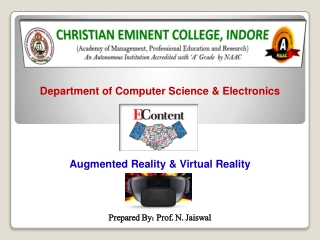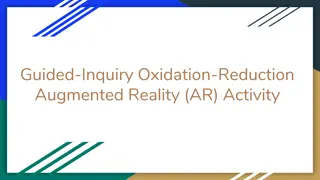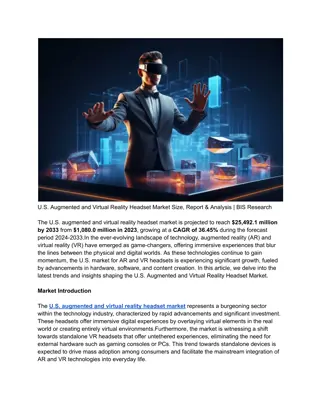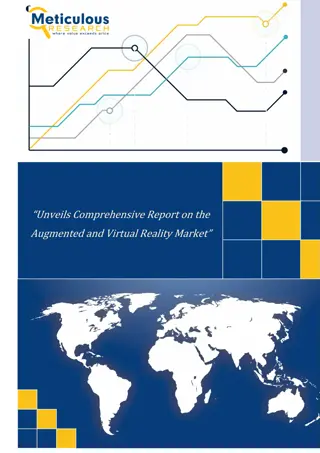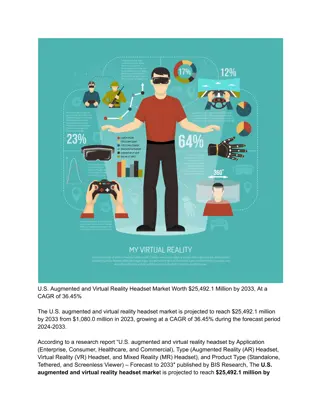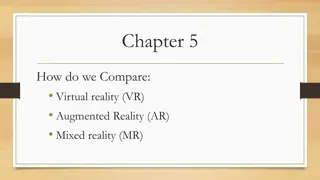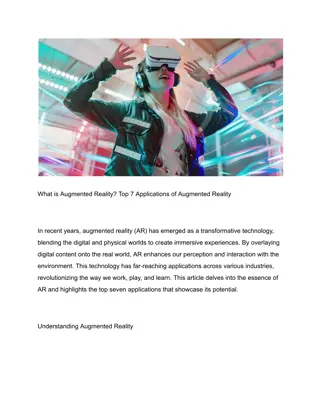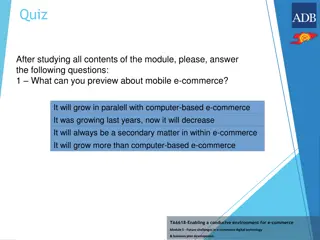
Augmented Reality in Food Retail: Transforming Consumer Experiences
Explore how augmented reality (AR) is reshaping the food retail sector by offering personalized experiences, increasing novelty, encouraging socialization, and enhancing accessibility. Discover the advantages and examples of AR in marketing, along with its potential drawbacks such as privacy concerns. Dive into the world of experiential consumption and the innovative applications of AR in creating unique customer interactions.
Download Presentation

Please find below an Image/Link to download the presentation.
The content on the website is provided AS IS for your information and personal use only. It may not be sold, licensed, or shared on other websites without obtaining consent from the author. If you encounter any issues during the download, it is possible that the publisher has removed the file from their server.
You are allowed to download the files provided on this website for personal or commercial use, subject to the condition that they are used lawfully. All files are the property of their respective owners.
The content on the website is provided AS IS for your information and personal use only. It may not be sold, licensed, or shared on other websites without obtaining consent from the author.
E N D
Presentation Transcript
Augmented reality Consumer food related applications: food retail sector and services. ELENA HORSK JOHANA PALUCHOV JAKUB BER K RENATA MATYSIK PEJAS ANDRZEJ KRASNODEBSKI - MONIKA SZAFRA SKA
Introduction of Augmented Reality Economists theorize, that the world currently finds itself in the experience economy . Experiential consumption is based more on a holistic experience, recognizing both the emotional and rational motives of consumption. Augmented reality (AR) is strongly supporting the creation of a unique experience; therefore it is increasingly being used in creative ways for apps, games, and shopping experiences.
Advantages of Augmented Reality Personalisation: the customer can upload their own content to create a personalised form of media which is marketed at them only. Novelty: AR is considered to be the latest thing on the technology front so there is still that drive to be an early adopter. Socialisation: there is the opportunity for customers to share their personalized content with others, i.e. viral AR marketing. Accessible: it enables customers who do not have the technical skills or know-how to create their own multimedia product.
Examples of Augmented Reality in marketing 1. Demand generation: augmented reality used to enhance websites, advertising and/or events: When AR is used on websites, it increases dwell time and there is a proven correlation between the dwell time on site and conversions. 2. Qualifying: augmented reality used to demonstrate product or credential presentations: Some innovative companies are choosing to invest in the sales process and make a good first impression by using AR to bring a presentation to life.
Examples of Augmented Reality in marketing 3. Proposing: modelling designs and products: For example, engineering firms spend hundreds of thousands of euros on 3D product models. There are a number of leading engineering and construction firms who are investing in AR modelling instead which can be much more cost effective and take much less time to complete. 4. Delivering: reporting and updating clients on projects: AR demonstrations can prove to be the death of distance and reduce the need for expensive international travel.
Disadvantages of Augmented Reality Privacy issues: The biggest issue with AR is definitely the privacy. With the use of facial recognition technology, combined with geo-location and augmented data will lead to a seamless integration of our online and offline live. Unauthorized augmented reality advertising: Once the general public gets used to navigating their physical environment with tools like Glasses, all of what is seen and shared will become searchable data. Augmented behavioural targeting: How would you control what information is collected and how it is used for advertising that blurs the boundaries between your physical and virtual worlds?
Disadvantages of Augmented Reality Physical danger: There are threats not only in form of an electromagnetic field generated around the devices but also the problem of distractive effects. Spam sending: Where there is a marketing opportunity, there will be spam, deceptive advertising techniques and social engineering tricks to dupe gullible consumers into paying for things they do not really need.
The use of augmented reality in retail and services sectors Marketing experts and observers say AR is much more than fun and games (Bulearca and Tamarjan, 2010). It offers an entirely new avenue for direct mail, an eye-catching and meaningful way to ensure that mail continues as a mainstay in multichannel communication AR can shine at best, where it can bring inanimate objects to life or where the provider needs to provide more information than can fit on his/her medium. That is the main advantage of AR for consumers, to get current, nice and relevant information anytime they want.
Practical application of augmented reality in restaurants QR Code: QR codes are designed to be scanned by any QR code- scanning app. Feedback and reviews: Create applications to give feedback or review a restaurant. The applications could be configured with the connection of QR code for example as the part of feedback, which could be visible for customers or could be seen on social networks as well. Virtual menu: The restaurant menu is the most important tool inside the restaurant. Foodie photos: The very best way to visually promote food is high quality, mouth wateringly setup photos.
Augmented reality applied in retail Beacon technologies: Beacon is basically a small computer that has its own processor, Bluetooth, heat and motion sensor. This technology provides several benefits for retailers, e.g. in connection with the application or loyalty program they can effectively target marketing campaigns for customers who are close to a store or product. 3D printing: Some electronics manufacturers already calculate in long-term plans that customers will print the spare parts and components at home with a 3D printer. Click & Collect: Many retailers now integrate the Click & Collect service, where customers can order goods online and pick them up directly in the store.
Augmented reality applied in retail Wearables: According to surveys, until 2020 each person will own on average more than four devices connected to the Internet, among which there will be at least one wearable device. Project Tango from Google: Tango is a technology platform developed and authored by Google that uses computer vision to enable mobile devices, such as smartphones and tablets, to detect their position relative to the world around them without using GPS or other external signals. Customer fun clubs: The greatest value will not be the customer who buys, but the person who buys although in smaller quantities, but will tell about his purchase to his friend who will also make a purchase.
Summary Advantages of Augmented Reality: Personalisation Novelty Socialisation Accessible Disadvantages of Augmented Reality: Privacy issues Unauthorized augmented reality advertising Augmented behavioural targeting Physical danger Spam sending Different examples of Augmented Reality were discussed aswell.

